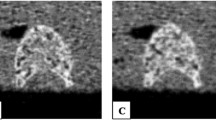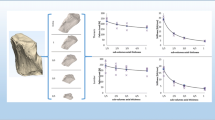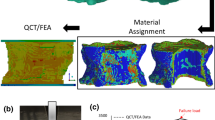Abstract
Patient-specific modeling could help in predicting vertebral osteoporotic fracture. The accuracy requirement for input data available in clinical routine is related to the model sensitivity. The objective of this study is to assess the relative impact of material properties and of loading conditions on vertebral strength using a finite element model. Fourteen subject-specific vertebral finite element models were used to investigate the effect of material properties and loading conditions. A design of experiment was set to study three parameters: Young’s moduli of trabecular bone and cortico-trabecular bone (outer 3 mm of the vertebra), and load location. Cortico-trabecular bone modulus variation from 270 to 478 MPa made fracture load vary from 22 to 51%, depending on other parameters. Trabecular bone modulus variation from 115 to 258 MPa made fracture load vary from 11 to 43%. Displacing load location by 1 cm resulted in a mean decrease of 48–60% of the fracture load. Anterior bending induced strain concentration in vertebral anterior wall. Material properties of both type of bone have about the same effect. Load location is the most sensitive. Effort should be made to take into account patients’ specific load distribution regarding its sagittal balance, in addition to bone properties.



Similar content being viewed by others
References
Buckley JM, Leang DC, Keaveny TM (2006) Sensitivity of vertebral compressive strength to endplate loading distribution. J Biomech Eng 128:641–646
Buckley JM, Cheng L, Loo K, Slyfield C, Xu Z (2007) Quantitative computed tomography-based predictions of vertebral strength in anterior bending. Spine 32:1019–1027
Buckley JM, Loo K, Motherway J (2007) Comparison of quantitative computed tomography-based measures in predicting vertebral compressive strength. Bone 40:767–774
Buckley JM, Kuo CC, Cheng LC, Loo K, Motherway J, Slyfield C, Deviren V, Ames C (2009) Relative strength of thoracic vertebrae in axial compression versus flexion. Spine 9:478–485
Busscher I, Ploegmakers JJW, Verkerke GJ, Veldhuizen AG (2010) Comparative anatomical dimensions of the complete human and porcine spine. Eur Spine J 19:1104–1114
Crawford RP, Keaveny TM (2004) Relationship between axial and bending behaviors of the human thoracolumbar vertebra. Spine 29:2248–2255
Crawford RP, Cann CE, Keaveny TM (2003) Finite element models predict in vitro vertebral body compressive strength better than quantitative computed tomography. Bone 33:744–750
Duan Y, Duboeuf F, Munoz F, Delmas PD, Seeman E (2006) The fracture risk index and bone mineral density as predictors of vertebral structural failure. Osteoporos Int 17:54–60
Faulkner KG, Cann CE, Hasegawa BH (1991) Effect of bone distribution on vertebral strength: assessment with patient-specific nonlinear finite element analysis. Radiology 179:669–674
Graeff C, Chevalier Y, Charlebois M, Varga P, Pahr D, Nickelsen TN, Morlock MM, Gluer CC, Zysset PK (2009) Improvements in vertebral body strength under teriparatide treatment assessed in vivo by finite element analysis: results from the EUROFORS study. J Bone Miner Res 24:1672–1680
Huang MH, Barrett-Connor E, Greendale GA, Kado DM (2006) Hyperkyphotic posture and risk of future osteoporotic fractures: the Rancho Bernardo study. J Bone Miner Res 21:419–423
Humbert L, De Guise JA, Aubert B, Godbout B, Skalli W (2009) 3D reconstruction of the spine from biplanar X-rays using parametric models based on transversal and longitudinal inferences. Med Eng Phys 31:681–687
Imai K, Ohnishi I, Yamamoto S, Nakamura K (2008) In vivo assessment of lumbar vertebral strength in elderly women using computed tomography-based nonlinear finite element model. Spine 33:27–32
Jones AC, Wilcox RK (2007) Assessment of factors influencing finite element vertebral model predictions. J Biomech Engin 129:898–903
Koivumäki JEM, Thevenot J, Pulkkinen P, Salmi JA, Kuhn V, Lochmüller EM, Link TM, Eckstein F, Jämsä T (2010) Does femoral strain distribution coincide with the occurrence of cervical versus trochanteric hip fractures? An experimental finite element study. Med Biol Eng Comput 48:711–717
Kolta S, Bras AL, Mitton D, Bousson V, De Guise JA, Fechtenbaum J, Laredo JD, Roux C, Skalli W (2005) Three-dimensional X-ray absorptiometry (3D-XA): a method for reconstruction of human bones using a dual X-ray absorptiometry device. Osteoporos Int 16:969–976
Kolta S, Quiligotti S, Ruyssen-Witrand A, Amido A, Mitton D, Bras AL, Skalli W, Roux C (2008) In vivo 3D reconstruction of human vertebrae with the three-dimensional X-ray absorptiometry (3D-XA) method. Osteoporos Int 19:185–192
Liebschner MAK, Kopperdahl DL, Rosenberg WS, Keaveny TM (2003) Finite element modeling of the human thoracolumbar spine. Spine 28:559–565
Lunt M, O’Neill TW, Felsenberg D, Reeve J, Kanis JA, Cooper C, Silman AJ (2003) Characteristics of a prevalent vertebral deformity predict subsequent vertebral fracture: results from the European prospective osteoporosis study (EPOS). Bone 33:505–513
Masri FE, Sapin-De Brosses E, Rhissassi K, Skalli W, Mitton D (2011) Apparent Young’s modulus of vertebral corticocancellous bone specimens. Comput Meth Biomech Biomed Eng. doi:10.1080/10255842.2011.565751
Matsumoto T, Ohnishi I, Bessho M, Imai K, Ohashi S, Nakamura K (2009) Prediction of vertebral strength under loading conditions occurring in activities of daily living using a computed tomography-based nonlinear finite element method. Spine 34:1464–1469
Melton LJ, Riggs BL, Keaveny TM, Achenbach SJ, Hoffmann PF, Camp JJ, Rouleau PA, Bouxsein ML, Amin S, Atkinson EJ, Robb RA, Khosla S (2007) Structural determinants of vertebral fracture risk. J Bone Miner Res 22:1885–1892
Pomero V, Lavaste F, Imbert G, Skalli W (2004) A proprioception based regulation model to estimate the trunk muscle forces. Comput Meth Biomech Biomed Engin 7:331–338
Roux C, Fechtenbaum J, Kolta S, Said-Nahal R, Briot K, Benhamou CL (2010) Prospective assessment of thoracic kyphosis in postmenopausal women with osteoporosis. J Bone Miner Res 25:362–368
Sapin-De Brosses E, Chan F, Ayoub G, Roux C, Skalli W, Mitton D (2009) Anterior bending on whole vertebrae using controlled boundary conditions for model validation. J Musculosk Res 12:71–76
Sapin-De Brosses E, Briot K, Kolta S, Roux C, Mitton D (2010) Subject-specific mechanical properties of vertebral cancellous bone assessed using a low-dose X-ray device. IRBM 31(3):131–181
Sapin-De Brosses E, Jolivet E, Travert C, Mitton D, Skalli W (2011) Vertebral strength prediction using subject-specific finite-element models derived from low dose imaging. Spine
Schultz AB, Andersson GB (1981) Analysis of loads on the lumbar spine. Spine 6:76–82
Silva MJ (2007) Biomechanics of osteoporotic fractures. Injury 38(Suppl 3):S69–S76
Stone KL, Seeley DG, Lui LY, Cauley JA, Ensrud K, Browner WS, Nevitt MC, Cummings SR (2003) BMD at multiple sites and risk of fracture of multiple types: long-term results from the study of osteoporotic fractures. J Bone Miner Res 18:1947–1954
Wilcox RK, Allen DJ, Hall RM, Limb D, Barton DC, Dickson RA (2004) A dynamic investigation of the burst fracture process using a combined experimental and finite element approach. Eur Spine J 13:481–488
Conflict of interest
The authors declare that they do not have any conflict of interest.
Author information
Authors and Affiliations
Corresponding author
Rights and permissions
About this article
Cite this article
Travert, C., Jolivet, E., Sapin-de Brosses, E. et al. Sensitivity of patient-specific vertebral finite element model from low dose imaging to material properties and loading conditions. Med Biol Eng Comput 49, 1355–1361 (2011). https://doi.org/10.1007/s11517-011-0825-0
Received:
Accepted:
Published:
Issue Date:
DOI: https://doi.org/10.1007/s11517-011-0825-0




